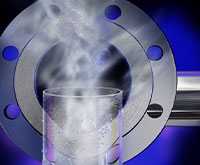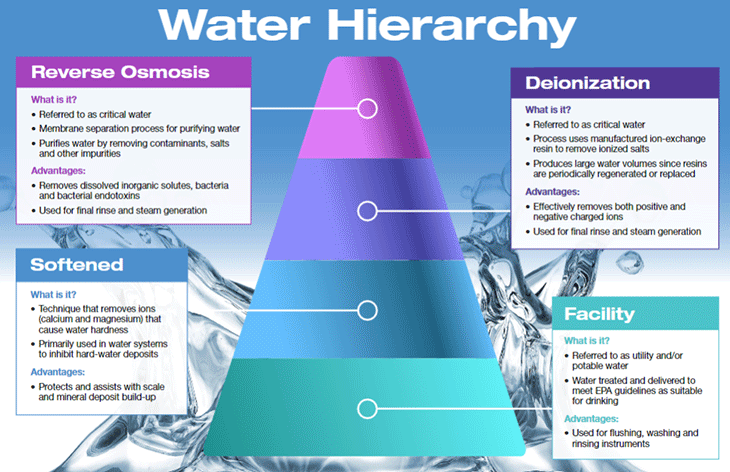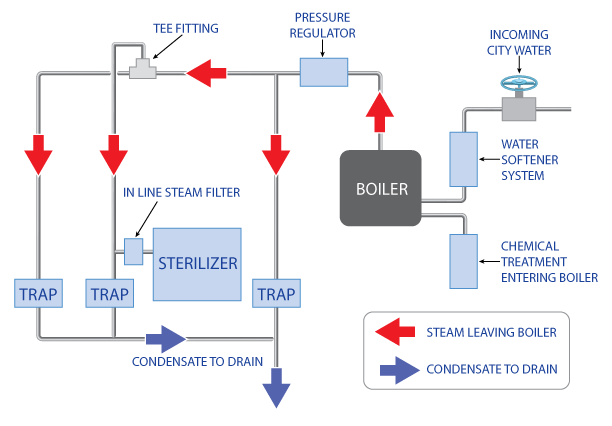Guide to Optimal Steam Generation

All types of steam can provide effective sterilization, but healthcare facilities have choices and should understand the different types of steam generation available. Everyone wants to minimize wet packs, instrument staining, and chamber scale/rouge, but all of these are dependent upon your steam quality and purity. While steam sterilization is a critical process for most healthcare facilities, the importance of the incoming water quality for steam sterilizers is often overlooked or misunderstood.
Importance of Water Quality in Steam Sterilization
Water, composed of hydrogen and oxygen, is known as “the universal solvent” because more substances dissolve in water than any other chemical. Therefore, tap water, otherwise known as potable water, may naturally contain minerals and other contaminants such as metals, salts, and organic molecules derived from the environment or the water delivery system. The following table identifies the potential effects of these factors on instruments being sterilized and suggested water treatment options:
| ELEMENTS THAT CAN AFFECT POTABLE WATER |
POTENTIAL IMPACT ON INSTRUMENTATION |
WATER TREATMENT OPTIONS |
| Presence of metals (aluminum, copper, iron, potassium, etc.) |
Instrument staining, chamber discoloration |
Addition of inline filters and/or de-ionized (DI) or reverse osmosis (RO) treatment system |
| Hardness (presence of calcium and magnesium) |
Scale formation from mineral deposits |
Addition of softeners in feed water |
| pH Factors (presence of carbonate, hydroxide, and bicarbonate) |
Instrument pitting, staining, and corrosion |
Addition of neutralizing amines in feed water |
If not monitored or treated properly, the above conditions may negatively impact the quality of steam production. Instrument decontamination methods used before sterilization should also be investigated to ensure they do not contribute to such issues. Developing a routine water quality testing and analysis program can help minimize such issues.
When deciding which water treatment option may be best for your facility, there are four primary levels of water to consider. The characteristics of each type are shown in the water hierarchy below.

Steam Quality Options for Sterilization

Steam quality can be categorized by the level of purity required by its end-use application.
- Pure Steam – Pharmaceuticals and biotechnology; injectable drug production. Uses water for injection (WFI).
- Clean Steam – Healthcare facilities, laboratories, food & beverage. Uses RO/DI water.
- Plant Steam – Healthcare facilities, laundries, food & beverage, pulp & paper, petrochemical. Uses softened/treated potable water.
While all types of steam can provide effective sterilization, all steam is not the same. This guide focuses on steam produced with potable or RO/DI water since pure steam produced with WFI water is not typically used in healthcare facilities.
Plant Steam

Plant steam is the most common type of steam used in U.S. healthcare and is sometimes referred to as house steam. Plant or house steam comes from a large, centrally located boiler and can be used for multiple applications, including sterilization, laundry, food service, and heating. The Sterile Processing Department (SPD) typically consumes 3-5% of total steam production for the average facility. It is important to know that steam quality may vary seasonally due to the need for heat during winter months or even at different times of each day during peak demand for kitchen, laundry, showers, etc.
Plant steam is the most economical to produce. The boiler water can be heated with electricity or use natural gas as the most cost-effective method for heating. Softened feed water may be used to decrease water hardness and reduce mineral deposits in the generator vessel.
Typical Plant Steam System within a Healthcare Facility
How is Plant Steam Made?
Incoming municipal water is treated with the use of a water softener. Chemical additives are also added to the boiler to aid in controlling foaming, hardness, and the pH level of the softened water. The steam leaving the boiler travels through a pressure regulator and plumbing lines that typically consist of black iron piping. If needed, inline filters can be added close to the sterilizer to control any particulates that may be transferred in the steam.
How is Plant Steam Maintained?
Boiler water is chemically treated to control pH levels, deposits, and foaming. It is important to prevent excessive amounts of boiler additives from being transported with the steam to the sterilizer, as this may result in undesirable deposits on the chamber and instruments.
- Key Learning Objective: For optimal steam penetration and processing results, steam should be “dry” and consist of 97% vapor and 3% liquid.
“Wet” steam (less than 97% vapor) can result in poor heat transfer and potential process control issues such as wet packs. Over a prolonged period, this may affect plant performance and increase maintenance and operational costs. Boiler operating pressure, water treatment management, and efficient distribution can influence the quality of steam within the process.
A well-designed and maintained steam system minimizes or prevents boiler carryover and is properly trapped to prevent excessive steam condensate or water droplets from reaching the sterilizer load.
Plant Steam Advantages and Disadvantages
| ADVANTAGES |
DISADVANTAGES |
| Lowest Cost Option |
Non-dedicated steam supply
may result in variability
in steam quality if not
properly maintained |
Requires no additional
equipment or floor space
in SPD |
Requires no additional
maintenance by
SPD staff |
Alternate Methods of Steam Generation
Some locations do not have a large central boiler system available to generate steam from potable water. In this case, steam can be generated within an SPD using an integrated or standalone electric steam generator. Electric steam generators contain heating elements that heat the water in a pressure vessel like an electric home water heater. With this option, the electric heating elements come into direct contact with the feed water to heat it and produce steam. Since they are dedicated to a particular sterilizer or washer, if properly sized for the equipment, a well-maintained steam generator can help eliminate the fluctuation in steam quality that may occur with the use of plant steam.
Integrated and Standalone Steam Generators
An integrated electric steam generator supplies a single sterilizer with steam. It is housed within the sterilizer framework and therefore works well in facilities where space is limited.
A standalone electric steam generator can be used to supply one or more sterilizers. Because it is independent of the sterilizer, it requires more floor space to install and more power (higher Kilowatt) if supplying multiple sterilizers.
Integrated and standalone generators can be constructed with carbon or stainless steel. Carbon steel construction is less costly than stainless and is suitable for use with sterilizers having copper/brass or stainless-steel piping. Both generator types require water quality that meets sterilizer manufacturer specifications. Hard feed water may need to be appropriately treated to avoid problems such as generator carryover, electric heating element burnout, and sludge build-up within the generator vessel.
Carbon Steel Generator Advantages and Disadvantages
| ADVANTAGES |
DISADVANTAGES |
Cost-effective alternative to
plant steam |
Potable water must meet
water specifications or must be softened |
Dedicated steam supply not
subject to plant steam
variation or boiler additive
carryover |
Must be flushed daily to
eliminate the build-up of deposits
that decrease heater life and
cause generator carryover (wet packs) |
Integrated Type:
Requires no additional
equipment or floor space
in SPD |
Standalone Type:
Requires additional floor
space in SPD
|
Clean Steam
Using clean steam for sterilization offers the advantage of fewer deposits on instruments and sterilizer chamber surfaces. Due to generally poor water quality and different regulatory standards, clean steam is used almost exclusively in Europe. To generate clean steam, a stainless-steel generator vessel is required, and per the National Boiler Code, it must be supplied with RO and/or DI water which contains no dissolved minerals. The resistivity of the water must measure >1 MΩ⋅cm. This is to avoid contamination and malfunctioning of the generator’s mechanical float switches.
It is important to know that due to the aggressive nature of the RO/DI water used in clean steam applications, the generator and sterilizer piping and components must be stainless steel. Stainless steel is a relatively hard, inactive metal that resists corrosion. In contrast, copper and brass are softer, more active metals. Since few ions are present in RO/DI water, ions from copper and brass sterilizer piping tend to leach into the water and eventually cause corrosion of the piping.
How is Clean Steam Made?
Electric heating elements can power clean steam generators, or they can use house steam to heat RO/DI water in a heat exchanger indirectly. This type of generator is also known as a steam-to-steam generator.
Electric clean steam generators can be integrated within the sterilizer framework to minimize footprint requirements or be standalone generators. Figure 2 shows a typical clean steam setup with a standalone or integrated steam generator.
Figure 2: Clean steam setup (electric)

Steam-to-steam or indirect clean steam generators use house (plant) steam to heat RO/DI water within a system of heat exchangers, with the house steam never coming into direct contact with the generator feed water. While this option is the most economical to operate, it is less efficient than an electric steam generator and has a much higher acquisition cost. With indirect steam generators, it is sometimes necessary to install a steam reservoir, also known as a “header”, to collect and store steam for processing and to increase the generator's efficiency. This type of steam generator usually also requires higher house steam pressure to perform properly. Figure 3 shows a clean steam system with a steam-to-steam generator. This type of generator is located near the sterilizer and usually requires additional floor space in the sterile processing area.
Figure 3: Clean steam layout within a hospital steam-to-steam (indirect)

While it is more costly to use treated water due to the acquisition and maintenance costs associated with a treatment system, there are also significant benefits. Stainless steel steam generators using treated water to create steam will last longer if properly maintained since hardness and other minerals are reduced to very low levels. Using treated water will also greatly diminish staining on the chamber walls and instruments.
- Key Learning Objective: Stainless steel means stain-resistant, not stain-proof. Implementing a clean steam system does not guarantee the corrosion-free operation of the sterilizer chamber or piping.
While many healthcare facilities use steam generated by a central boiler system, clean steam may reduce chamber cleaning efforts and can reduce the cost of maintaining and replacing instruments.
How is Clean Steam Maintained?
In addition to routine water quality monitoring and maintenance of water treatment equipment, proper cleaning, and maintenance of the sterilizer and generator are critical to ensure successful sterilization. Electric stainless steel generators should be flushed at least once a week to prevent scale and sludge build-up.
Clean Steam Advantages and Disadvantages to CSSD
| ADVANTAGES |
DISADVANTAGES |
Dedicated, consistent steam
supply with less
generator maintenance
(flush only 1x/week) |
Higher production cost
to generate steam
(additional capital, utility,
and maintenance requirements) |
Fewer deposits on chamber
and less staining on instruments |
May require additional
floor space for a steam generator |
Aligns with future AAMI
water and steam
generation requirements |
Aggressive to piping
and components
(Requires stainless steel) |
What are the Steam Generation Requirements for Healthcare?
In the US, ANSI/AAMI ST79 provides guidance on steam quality for healthcare applications. According to the standard, “there are two common sources for steam used for sterile processing: hospital steam boiler systems and self-contained, electric boilers. In both cases, a treated water supply is necessary to remove total dissolved solids (TDS). Each system should be designed, monitored, and maintained to ensure that the quality, purity, and quantity of the steam provided are appropriate for effective sterile processing.” Therefore, steam quality depends heavily on the water quality used for steam production. AAMI has made recommendations with respect to the water quality for the reprocessing of medical devices in its Technical Information Report (TIR) 34. It is expected that AAMI will eventually migrate this document to a standard, in which case it will be very important to understand the water quality used to generate steam. It is recommended that steam condensate be tested to determine the level of minerals or other contaminants in the steam.
In summary, using plant steam from a central facility source or steam generated in the SPD with an electric or steam to steam generator are all viable options for sterilizing surgical instruments. Choosing whether or not to implement clean steam depends on overall SPD objectives, including available space, budget and maintenance considerations, and the desire to prepare for future changes in AAMI standards.
If replacing older sterilizers, it may be worthwhile to consider steam sterilizers with stainless piping. This configuration is the most versatile as it is “clean steam ready”. This means that it can be supplied with house steam today and can be equipped with a stainless-steel generator for clean steam tomorrow, offering the flexibility to conform to anticipated changes in the standards.
Summary of Steam Generation Options and Feed Water Requirements
| Sterilizer Steam Supply Piping Material |
Steam Generator Type/Material |
Generator Feed Water Type |
Clean Steam
(Yes or No) |
| Potable Tap or Softened Potable Tap Water |
RO/DI |
| Copper/Brass |
Central plant steam carbon steel |
|
|
No |
| Integrated carbon steel |
|
|
No |
| Standalone carbon steel |
|
|
No |
| Stainless-Steel |
Central plant steam carbon steel |
|
|
No |
| Integrated carbon steal |
|
|
No |
| Standalone carbon steel |
|
|
No |
| Integrated stainless steel |
|
|
Yes |
| Standalone stainless steel |
|
|
Yes |
| Stand-alone stainless steel steam-to-steam |
|
|
Yes |
Steam Generation Maintenance Checklist
Proper steam system design and maintenance is required to achieve consistent and successful steam sterilization outcomes while minimizing wet packs, instrument staining, chamber scale, and rouge. The following checklist can be a useful tool for SPD Managers who wish to take a proactive approach to steam generation in their facilities.
Glossary of Terms
Solvent – liquid in which a solute is dissolved to form a solution.
Potable water – Drinking water or potable water is water that is safe enough to be consumed by humans or used with a low risk of immediate or long-term harm.
Carryover – solids in the form of metals or residues which are transferred from plumbing lines to the steam sterilizer chamber and/or surgical instruments.
Scale formation – a deposit of minerals left after the evaporation of water.
Neutralizing amines – used to neutralize the acid generated by the dissolution of carbon dioxide in the boiler water.
Water softener – a device or substance that softens hard water by removing certain minerals.
De-ionized (DI) Water System – utilizes a chemical process whereby an ion exchange resin is used to trap specifically charged ions such as Sodium, Calcium, Iron, Copper, Chloride, and Bromide.
Reverse Osmosis (RO) Water System – a liquid filtration method whereby water is forced through a membrane at high pressure. Small pores in the membrane permit the passage of water molecules but prevent the larger ions mentioned previously from passing through, resulting in water that is free of most dissolved minerals.
Expert Advice
A highly qualified, industry-recognized team of chemists, engineers, and service professionals is available to offer product and process consultation for your steam generation requirements. Only STERIS can provide solutions designed to work in concert to help you get the results you need, time and time again. Contact your STERIS Rep today for more information on steam generation.
 United States
United States
 Canada (EN)
Canada (EN) Canada (FR)
Canada (FR) Deutschland
Deutschland Italia
Italia United Kingdom
United Kingdom Australia
Australia New Zealand
New Zealand Singapore
Singapore Brasil
Brasil México
México








